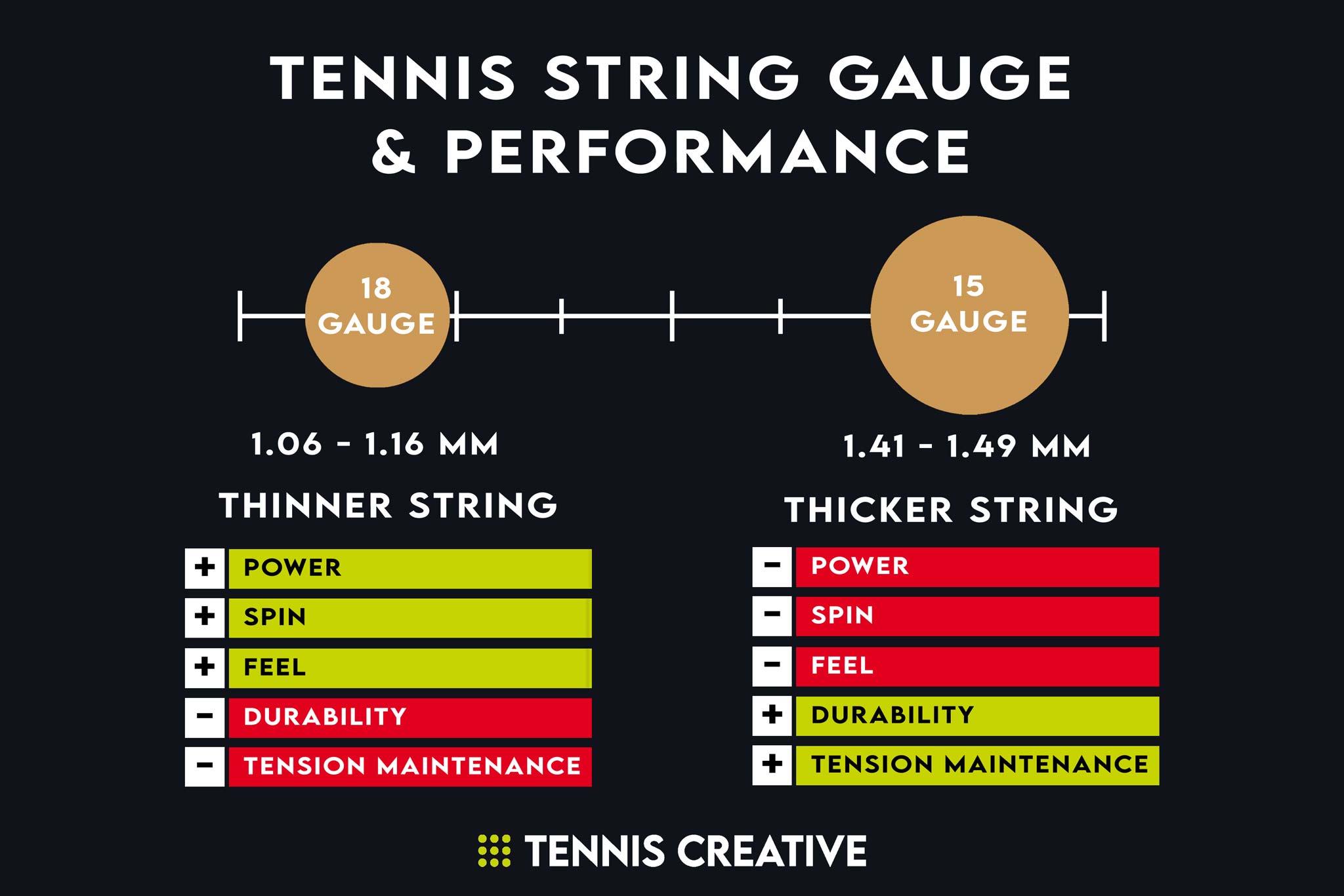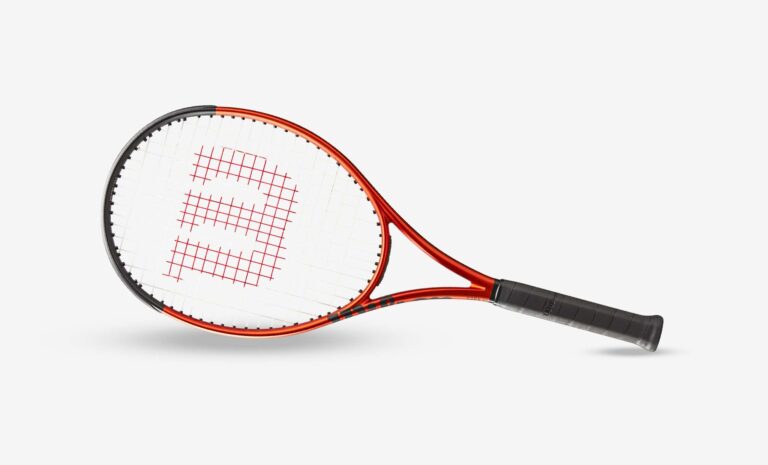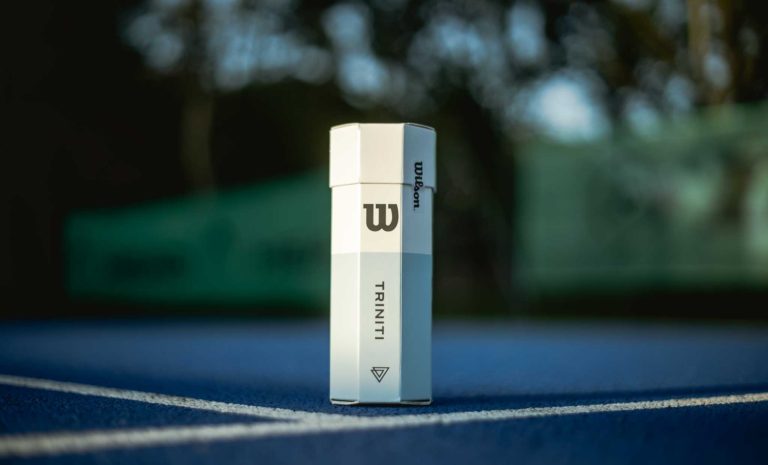If choosing the right type of tennis string wasn’t hard enough, you’ll also need to decide which tennis string gauge you want too. It can all be a little confusing, so we’ve put together a guide to tennis string gauge, including the effect string gauge has on a string, as well as how to choose the best one for your game.
What is Tennis String Gauge?
Tennis String Gauge refers to the thickness or diameter of a tennis string. Simply put, some tennis strings are thicker than others, and the gauge of a tennis string can have a significant impact on the performance of a string and the player. Generally speaking, thinner strings often offer more playability, while thicker strings offer better durability.
Tennis String Gauge Sizes & Measurements
As with most things in tennis, there are multiple measurement types for string gauges: a US gauge, the measurement of the string diameter in millimetres and an International gauge. The most commonly used are the US gauge and millimetre measurement, though we’ve also included the International gauge for your reference should you need it.
- It’s important to note that the US Gauge measurements are inverted, with higher gauges referring to thinner strings. 19 gauge refers to the strings at the thinner end of the scale, while 15 gauge refers to strings at the thicker end of the scale.
- US Gauges refer to a range of of sizes and not necessarily one specific measurement. For example, 17 gauge refers to any strings between 1.16 – 1.24 mm.
- Note that there are “light” or slightly thinner versions of 15 and 16 gauge strings. These gauges a known as 15L and 16L.
Typically, you’ll find the gauge of a tennis string marked out on the string packaging and in some cases, you may also find it printed onto the actual string.
Tennis String Gauge Chart
To make it easier for you to compare string gauges and their performance in a quick and easy way, we’ve created a tennis string gauge chart which will help you visualise it:

The Effect of String Gauge on Performance
Tennis string gauge has a massive impact on the performance of a tennis string, be it on the playability of the string or its durability. Here’s the short version:
Thinner Strings:
- Generate more power
- Generate more spin potential
- Provide more feel and comfort
- Are less durable
- Lose tension quicker
Thicker Strings:
- Generate less power
- Generate less spin potential
- Provide less feel and comfort
- Are more durable
- Maintain tension longer
However, if you’d like to read more about the effects of string gauge on performance, we’ve gone into a little more detail below.
Power
The amount of power produced when hitting a tennis ball depends in part on a process called “dwell time” or “contact time”. In short, dwell time is the amount of time the ball remains in contact with the string bed. Looser strings increase dwell time, consequently allowing the player to generate more power. Thicker tennis strings produce a stiffer string bed, which often doesn’t allow the strings to displace as much, producing less power.
Control
As we mentioned above, a thicker string produces a stiffer string bed allowing the strings to displace less therefore and generate less power. It’s fairly obvious that power and control are heavily dependent on each other in that more power leads to an overall sense of less control. So it’s only natural that a thicker string that generates less power will provide more control. That being said, the overall control provided by a string also depends on its spin potential.
Spin Potential
The spin potential of a tennis string depends significantly on the displacement of the strings. In simple terms, when a tennis ball is hit, the strings displace and “wrap around the ball”. Thinner strings tend to “cut into” the ball a little more, often generating more spin potential.
Comfort & Feel
Generally, thinner strings offer more feel and comfort than thicker strings. Thicker strings usually produce a stiffer string bed than thinner strings, often leading to a more “dull’ or “dead” feel. That being said, the comfort and feel of a string also depends massively on the string materials and construction, as well as the tension they are strung with. Thicker tennis strings are often strung at a slightly lower tension to make the string a little more comfortable to play with.
Durability & Tension Maintenance
Every time a player hits a tennis ball, friction is produced at the cross-sections where the strings overlap, causing them to wear. Gradually, the string will cut into each other and begin to notch. Eventually, the notches will cause the string to snap or break. So it will come as no surprise that when comparing two strings of the same type, a thicker string will last slightly longer than a thinner one. For instance, the 16 gauge version of say Babolat RPM Blast will last slight longer than the 17 gauge version of the same string.
Regarding the ability of a string to maintain tension, we come back to the idea of dwell time and string bed stiffness. Long story short, a stiffer string bedd causes less stretching of the strings, allowing them to maintain their tension longer. So, thicker strings will maintain their tension longer than thinner strings.
Which String Gauge do the Pros Use?
Here are the tennis strings that some of the pro tennis players use:
In the case of pro tennis players, durability more often refers to tension maintenance, as they’re looking to keep a more consistent string playability for the 8 games they use each racquet for. As you can see, many players use 16 gauge strings, which offer a balance between between high playability and good durability.
Which String Gauge Should You Use?
The tennis string gauge you use will depend mainly on your personal preferences. That being said, we’d usually recommend starting with a 16 gauge string. It’s sort of a middle ground, so offers a good balance between performance and durability. As you progress though the tennis ranks, you’ll likely find yourself favouring either performance or durability, so will be able to determine if you want a thinner or thicker string. Ideally, you should start with a string that is available in multiple gauges, so you can go for a bigger or smaller gauge depending on your preferences.
High performance players tend to prefer playing with thinner strings as they prioritise feel and comfort over all else. Club players and people who play tennis less frequently tend to prefer thicker strings that offer a little more durability.
Hopefully, we’ve made understanding tennis string gauge a little easier for you. If you have any questions about string gauges that we might be able to help with, let us know in the comments below!




